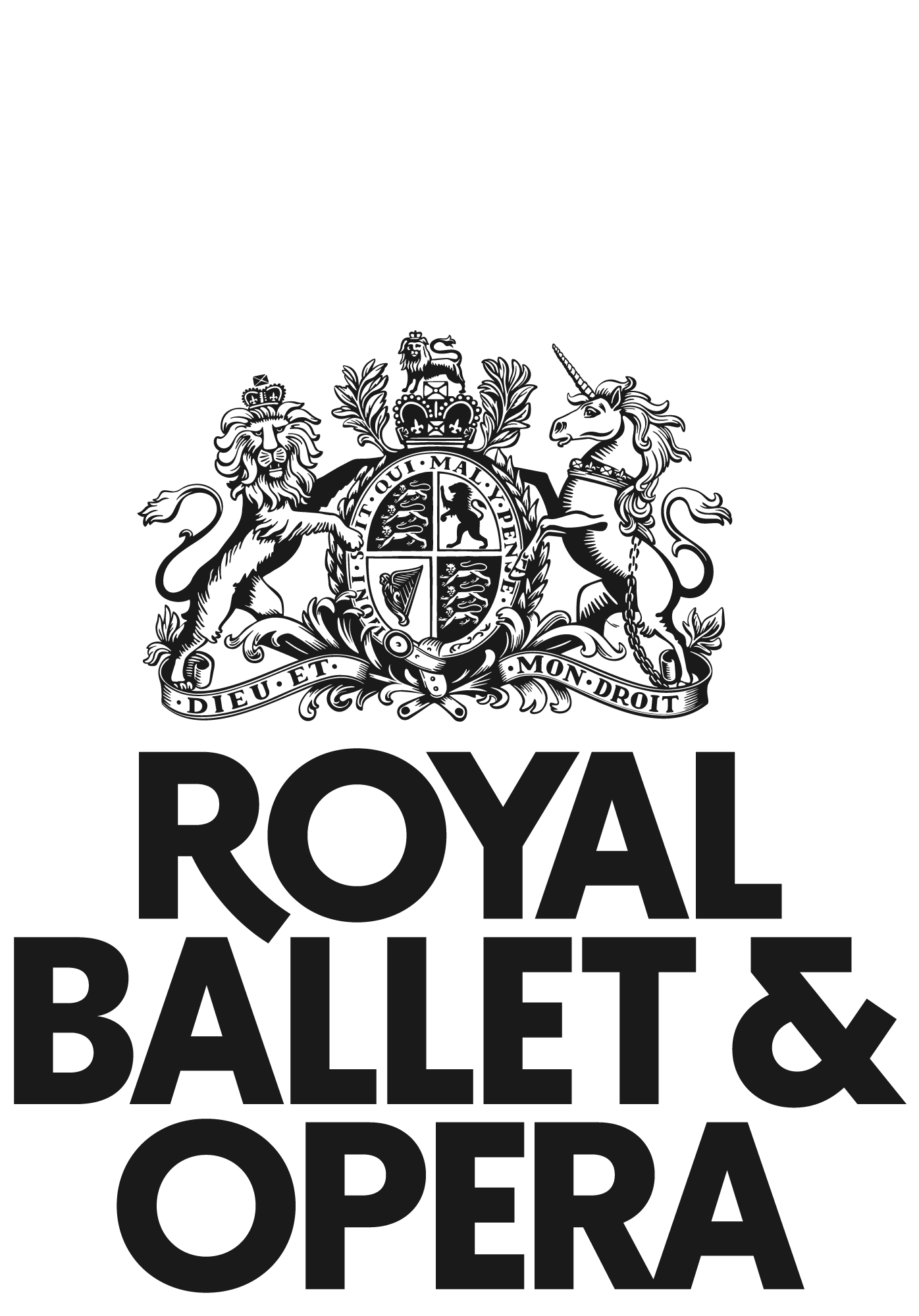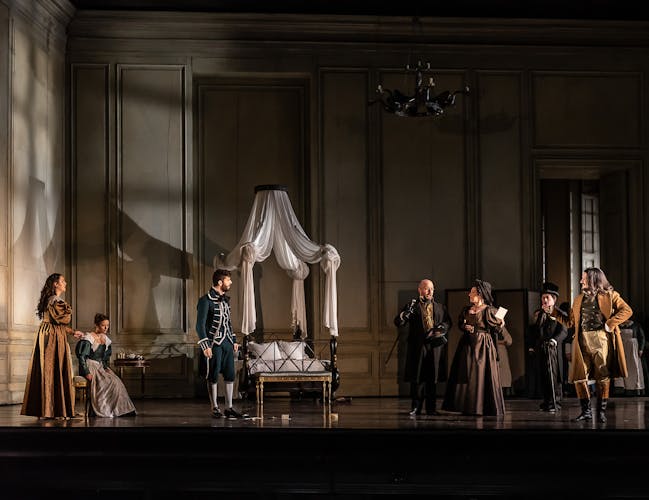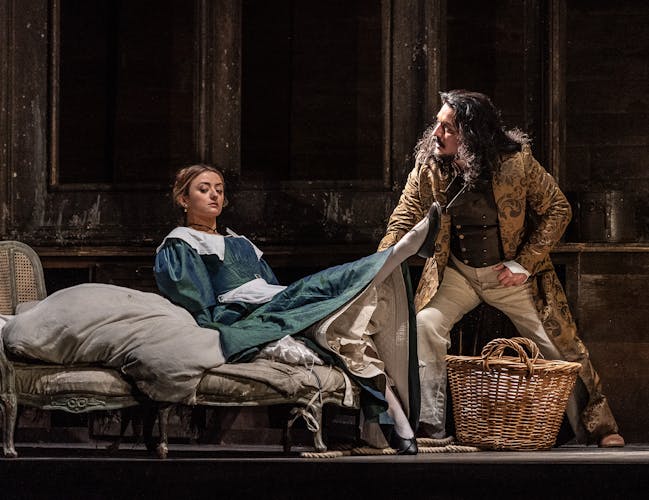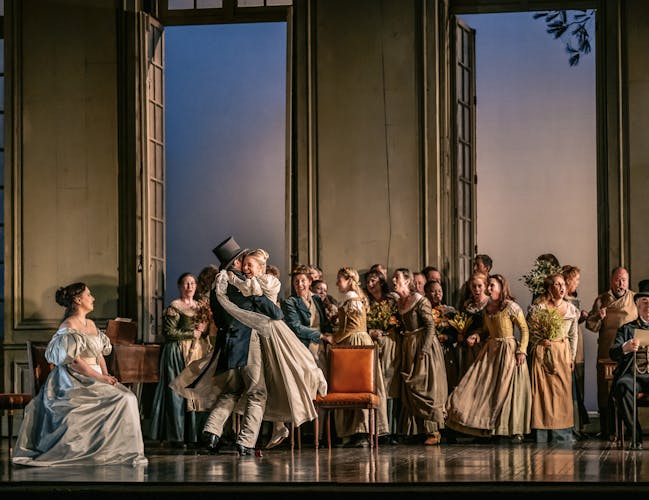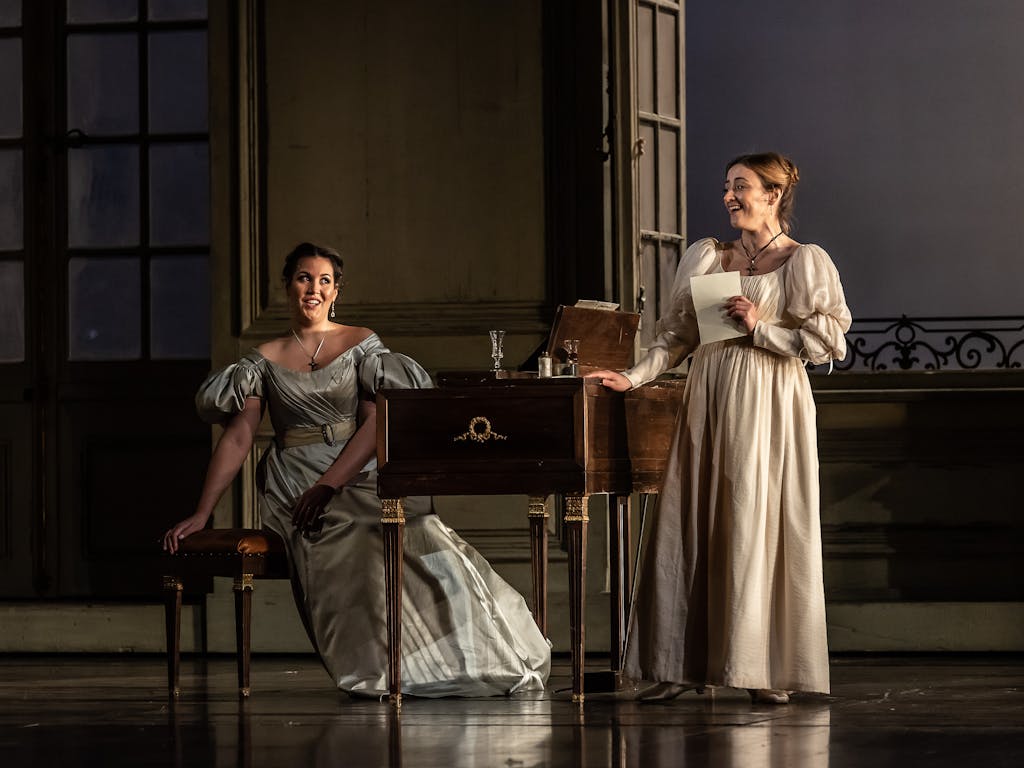The Marriage of Figaro
A guide to Mozart’s comic opera of intrigue, misunderstanding and forgiveness.
It’s Figaro’s wedding, and you’re invited to join the Almaviva household for an uproarious day of revelation and scandal.
Quick Facts
Who wrote The Marriage of Figaro?
The music for The Marriage of Figaro was written by Wolfgang Amadeus Mozart, with its first performance in 1786. The libretto (dialogue and lyrics) was written by Lorenzo da Ponte.
The Royal Opera's current production is directed by David McVicar.
Why was The Marriage of Figaro controversial?
The Marriage of Figaro was initially banned due to its merciless satire of the upper classes, and so Da Ponte toned down much of the libretto’s political content. The result was a great success, with sold-out performances in Vienna and a frenzy of appreciation in Prague, where Mozart reported hearing 'nothing but Figaro!' on the streets. David McVicar’s production, created in 2006, sets the action in a château in 1830 on the eve of France's second revolution. He explores the political and class conflicts at the core of Beaumarchais' play, while maintaining Mozart and Da Ponte's humanity and wit.
What is the story behind The Marriage of Figaro?
Composed in 1816 by Rossini, The Barber of Seville is the narrative prequel to Mozart’s The Marriage of Figaro, depicting the courtship of Rosina and Lindoro (aka the Countess and Count Almaviva) before their marriage. Prior to acting as servant to Count Almaviva, Figaro was a barber: a role he exploited to enable the lovers to outwit Rosina’s guardian.
Is The Marriage of Figaro a good opera for beginners?
Mozart’s comic opera is packed with plot twists, forbidden desires and unforgettable melodies, combining laugh-out-loud comedy with moments of breathtaking beauty – the perfect way to fall in love with opera.
History
For and against the emperor
Mozart had come to Vienna in 1782 intending to write for Joseph II’s Singspiel theatre. However, Joseph II disbanded this group and set up a new Italian opera company in 1783. Eager to write an opera buffa, Mozart eventually managed to secure the services of Lorenzo da Ponte, official librettist for Joseph II’s opera company. Their first commission, Le nozze di Figaro, had its premiere at the Vienna Court Theatre on 1 May 1786.
Da Ponte took the libretto for Le nozze di Figaro (The Marriage of Figaro) from the play La Folle Journée ou Le Mariage de Figaro by the French playwright and diplomat Pierre-Augustin Caron de Beaumarchais. The play was considered scandalous – largely due to Figaro’s Act V monologue in which he rails against the aristocracy – and was banned in Vienna. Da Ponte claimed that it was only due to his powers of persuasion that Joseph II allowed his and Mozart's opera to go ahead.
Synopsis
Characters
- Figaro – valet to the Count
- Susanna – Figaro's fiancée and maid to the Countess
- Count Almaviva – The Count
- Countess Almaviva – His Countess
- Cherubino – A young page boy
- Bartolo – The Countess' guardian
- Marcellina – Bartolo's housekeeper
- Don Basilio – The household music teacher
- Antonio – The household gardener
- Barbarina – The gardener's daughter
Count Almaviva lives with his Countess on their estate near Seville. The Count has his eye on his wife’s maid Susanna, who is about to marry the Count’s manservant, Figaro. The Count plans to seduce Susanna in the tradition of the droit de seigneur, whereby an aristocrat could bed any female servant on her wedding night. Figaro is not happy with this. Cherubino, the Count’s young page, has a crush on the Countess, who protects him. But the Count has just dismissed Cherubino from his service after the page was found with the gardener Antonio’s daughter, Barbarina.
Susanna and Figaro prepare their new bedroom. Figaro decides he must foil his master’s attempt to seduce Susanna. Marcellina has a legal claim on Figaro and plots with Doctor Bartolo to prevent Figaro’s wedding. Cherubino comes to see Susanna in a panic, but hides when the Count arrives to solicit a meeting with Susanna that night. The Count hides when Don Basilio arrives to persuade Susanna to give in to the Count. Don Basilio gossips about Cherubino’s infatuation with the Countess. The Count angrily bursts out of hiding and discovers Cherubino. Into the confusion come Figaro and the entire household. They stage a scene to praise the Count for giving up the droit du seigneur. Annoyed, the Count prevaricates about Figaro’s wedding and tells Cherubino he must join the army at once.
In the Countess’s apartment, the Countess, Susanna and Figaro plan a trap for the Count, using Cherubino disguised as a woman. The Countess flirts with Cherubino, who locks himself in the dressing room when the Count unexpectedly turns up. The Count is suspicious and goes to find an axe with which to break the locked door. While he is away, Cherubino escapes, and Susanna takes his place in the dressing room to fool the Count. But Cherubino is seen escaping by Antonio. Figaro tries to explain everything, but his story seems increasingly far-fetched. Marcellina arrives with her claim, and the Count is delighted to have an excuse to stop Figaro’s wedding plans.
The Count is increasingly confused. Susanna and the Countess plan Susanna’s night-time assignation with the Count – with the Countess disguised as Susanna. At first, the Count falls for the trap, but a remark of Figaro’s makes him suspicious. Barbarina smuggles Cherubino back disguised as a girl. Marcellina drops her claim when she and her former lover Bartolo discover Figaro is their long-lost son. Cherubino is discovered and his earlier escape exposed. But Barbarina knows secrets with which to blackmail the Count and save Cherubino. The Count commands they all celebrate Figaro’s wedding, secretly expecting that he will meet Susanna later.
Figaro believes that Susanna is unfaithful and comes to the garden that night to get revenge, but eventually realizes the real plan of the Countess and Susanna. There are a succession of mistaken identities, confusions and misunderstandings. But out of them, the Count’s behaviour is finally exposed and he seeks the forgiveness of his wife.
Pictures and Videos
Gallery
A great reunion
As with all the best farces, the events of The Marriage of Figaro are incredibly complicated. The valet Figaro has been pursued from the start of opera by the housekeeper Marcellina, whom he has agreed to marry if he can't repay a longstanding debt. Marcellina has chosen the day of Figaro's wedding to his fiancée Susanna to stake her claim, encouraged by Figaro’s old enemy, Bartolo, and Figaro's master, Count Almaviva, who wants to claim Susanna as his mistress. In the hilariously implausible reunion that ensues, Mozart and his librettist Lorenzo da Ponte deploy their skills to the full in a devilish display of musical and poetic wit.
All six of the main characters join together to sing the sextet ‘Riconosci in questo amplesso’ – 'I recognise you in this embrace'. The beginning of the sextet is infused with happiness as the reunited Marcellina, Figaro and Bartolo embrace. This joyous opening is briefly interrupted by interweaving exclamations of surprise and confusion from the Count and Don Curzio, but the re-entry of Marcellina, Figaro and Bartolo with a soaring theme ‘Figlio amato! Parenti amati!’ (Beloved Son! Beloved Parents!) recaptures our attention. Susanna's arrival prompts a dainty yet cautious melody, hinting at unrest to come. Seeing Marcellina and Figaro embrace, Susanna mistakenly surmises that Figaro has agreed to marry Marcellina, and expresses her fury. Figaro tries to intercede with the words ‘Senti, oh cara!’ (Hear me, my dear!), ‘Senti questa’ (Hear this), she shoots back, followed by a slap – Da Ponte's text puns on the double meaning of ‘sentire’ as 'to hear' and 'to feel'.
A comical passage follows in which all sing in entangling melodic lines. Mozart evokes their confusion and mixed emotions – the Count sings an angry theme adopted by Don Curzio and the distressed Susanna, while Marcellina, Bartolo and Figaro sing in soothing melodic lines in an attempt to smooth over the situation. Finally, Marcellina explains things to Susanna and the melody returns to the opening theme – a happy ending for all.
Watch more
Watch a performance
The Marriage of Figaro runs from 2 – 15 September 2024. There are many other ways to watch:
- Main Stage
The Marriage of Figaro
- Opera and Music
It’s Figaro’s wedding, and you’re invited to join the Almaviva household for an uproarious day of revelation and scandal.
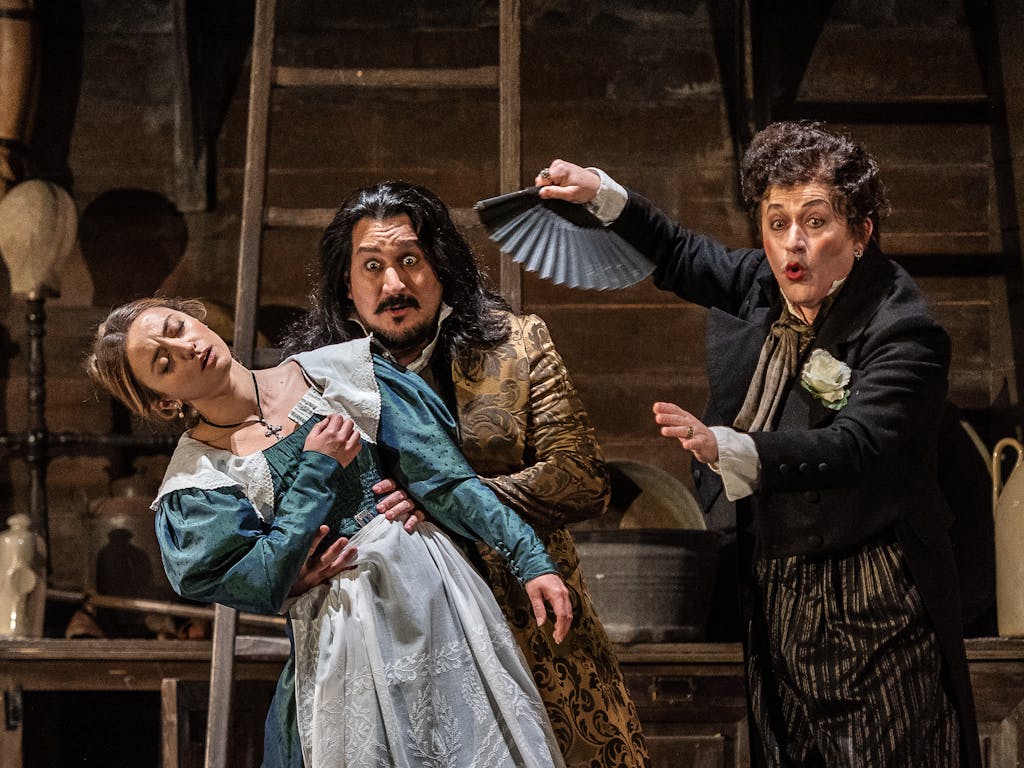
Watch online
You can watch the production as well as behind-the-scenes insights, interviews and introductions on Royal Ballet and Opera Stream.
Royal Opera House Covent Garden Foundation, a charitable company limited by guarantee incorporated in England and Wales (Company number 480523) Charity Registered (Number 211775)
